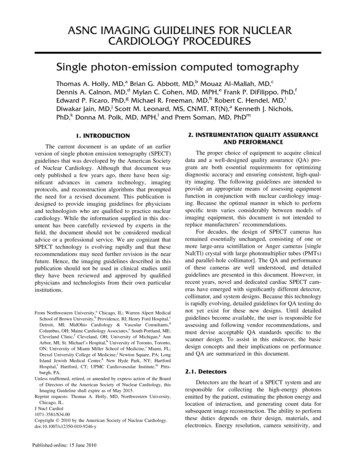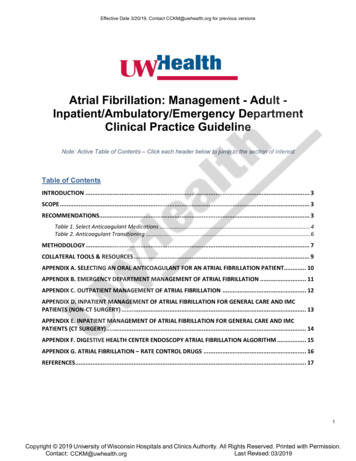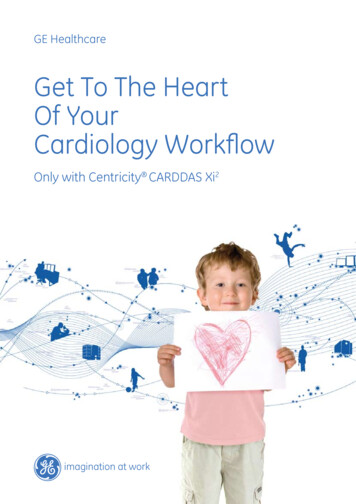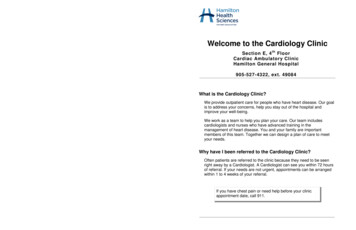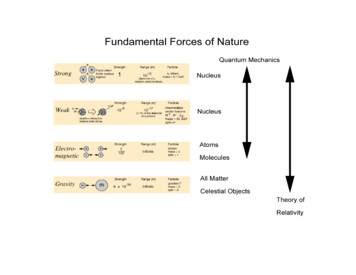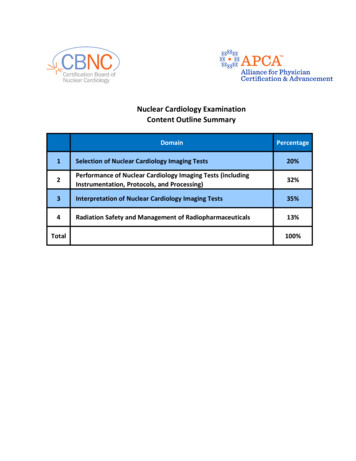
Transcription
Nuclear Cardiology ExaminationContent Outline SummaryDomainPercentage1Selection of Nuclear Cardiology Imaging Tests20%2Performance of Nuclear Cardiology Imaging Tests (includingInstrumentation, Protocols, and Processing)32%3Interpretation of Nuclear Cardiology Imaging Tests35%4Radiation Safety and Management of Radiopharmaceuticals13%Total100%
Certification Board of Nuclear Cardiology Content Outline(Detailed Outline)11.ASelection of Nuclear Cardiology Imaging Tests 20%Synthesize clinical data (history, physical exam, other testresults, etc.)1.B Determine appropriateness of test ordered1.C Select appropriate stressorSelect appropriate radiopharmaceutical and dose (including1.D knowledge of radiation biology, radiation physics, andinstrumentation)1.ESelect appropriate imaging protocol (stress/rest, rest/stress,stress only, viability, etc.)1.FSelect appropriate imaging modality (SPECT, PET, radionuclideventriculography)Effective 2018Knowledge, skill and/or ability related to selection of nuclear cardiologyimaging testsAbility to take relevant history for risk assessmentAbility to perform a target‐oriented physical examination to ascertain safety forstress testingAbility to utilize other test results to complement nuclear imagingKnowledge of pretest risk (Bayes theorem, etc.)Knowledge of statistics as it applies to evaluating clinical testsAbility to apply appropriate use criteriaAbility to assess patient’s ability to perform sufficient exerciseKnowledge of indications and contraindications of various stressor modalities(pharmacologic stress, exercise stress, etc.)Knowledge of indications for transition from submaximal exercise topharmacologic stressKnowledge of impact of current medications (caffeine, dipyridamole, theophylline,etc.) on pharmacologic vasodilator stress testKnowledge of mechanism of action of stressors (pharmacologic, exercise, etc.)Ability to synthesize patient characteristics in selecting radiopharmaceutical anddose (weight‐based dosing, circumference/distribution of weight, etc.)Knowledge of SPECT radiopharmaceuticals and their characteristics (production,energy, half‐life, etc.)Knowledge of importance of understanding hazards of radiation and need forALARAKnowledge of principles of radiation physics (scatter, types of electromagneticemissions, shielding, etc.)Knowledge of radiation biology (absolute dose, equivalent dose, effective dose,units, etc.)Knowledge of first‐pass myocardial extraction, redistribution, and retention ofdifferent perfusion tracersKnowledge of biological effects on the bodyKnowledge of how SPECT and PET systems acquire imagesKnowledge of impact of SPECT and PET radiopharmaceuticals and theircharacteristics on test selectionKnowledge of advantages and limitations of SPECT and PET imagingAbility to synthesize patient characteristics with other considerations in selectingprotocolsKnowledge of imaging protocols and their advantages/disadvantagesKnowledge of different viability protocols (PET FDG, thallium, SPECT, nitrate‐enhanced technetium, etc.)Knowledge of benefits and applications of stress‐only imaging
2Performance of Nuclear Cardiology Imaging Tests (includingInstrumentation, Protocols, and Processing) 32%Instruct and prepare patient (using printed/recorded material,2.Asecuring patient consent, etc.)2.BPerform stress tests (including complications and side effectsof stress testing)2.C Administer radiopharmaceuticals2.D Define acquisition parameters (positioning of patient, etc.)2.E Acquire images [with or without attenuation correction]2.F Utilize solid‐state camerasPerform SPECT, PET, SPECT/PET imaging (including viability,2.G perfusion, novel methods, myocardial flow reserve, andinflammation imaging)2.H Interpret coronary blood flow2.ISelect optimal imaging protocols [PET vs SPECT]2.JProcess images (filtered back projection, iterativereconstruction, motion correction, etc.)2.KPerform routine camera quality control processes (daily floodtests, center‐of‐rotation checks, etc.)2.LPerform routine non‐camera instrumentation quality controlprocesses (survey meter calibration, dose calibrators, etc.)Effective 2018Knowledge, skill and/or ability related to performance of nuclearcardiology imaging tests (including instrumentation, protocols, andprocessing)Knowledge of impact of medications on stress myocardial perfusion resultsKnowledge of impact of patient positioning on resultsKnowledge of potential complications of agents used in stress testingKnowledge of stress protocolsKnowledge of pertinent physiology/pathophysiology as it applies to stress testingKnowledge of how to manage complicationsKnowledge of when to terminate testKnowledge of pharmacokinetics of radiopharmaceuticalsKnowledge of SPECT and PET tracers and their effectsKnowledge of adequacy of countsKnowledge of standard acquisition parameters and variablesKnowledge of time vs radiotracer dose conceptsKnowledge of types of attenuation correctionKnowledge of benefits and limitations of attenuation correctionKnowledge of optimal timing of acquisition after radiotracer administration, basedon radiotracer kinetics and distributionKnowledge of equipment and quantum mechanisms in play in image acquisition(collimators, crystals, photomultiplier tubes, etc.)Knowledge of multigated acquisitions (MUGAs)Knowledge of the physics of imagingKnowledge and application of specific protocols for perfusion and viabilityassessmentKnowledge and application of dynamic myocardial blood flow imaging protocols,and calculation of coronary flow reserveKnowledge and application of novel SPECT, PET, and SPECT/PET protocols (sarcoid,amyloid, I‐123‐MIBG, etc.)Knowledge of pertinent physiology/pathophysiologyKnowledge of physiology/pathophysiologyAbility to assess absolute coronary blood flowAbility to assess coronary flow reserveKnowledge of benefits and limitations of different methods of image processing(ramp filter, iterative reconstruction, etc.)Knowledge of the physics and mechanisms of image processing (including filteredback projections)Knowledge of frequency cutoffsKnowledge of different filters and reconstruction methodsKnowledge of data reorientation and displayKnowledge and application of motion‐correction algorithmsKnowledge of strengths and limitations of motion correction (vertical, horizontal,etc.)Knowledge of gated SPECT processing and artifactsKnowledge of processing of MUGA images, including quantifying EF and volumes(septal view, background noise, etc.)Knowledge of mechanics of quality control processes (intrinsic/extrinsic floods,differing radiation detectors, differing dose calibrators, etc.)Knowledge of regulatory requirements for quality controlAbility to identify common abnormalities during quality control processes(photomultiplier tube out, center‐of‐rotation error, etc.)
3Interpretation of Nuclear Cardiology Imaging Tests 35%Review raw data and interpret extracardiac findings (including3.A oddities out of normal perfusion interpretation, RVhypertrophy, and papillary muscle)Assess and manage image quality (repeat scan; perform proneimaging; wait for gastrointestinal clearance; have patient drink3.Bwater; perform upright imaging; perform usual supine imaging;etc.)3.CAssess functional information and its reliability (includinggated images and viability)Assess disease‐specific processes (sarcoid, amyloid, infection,3.D heart failure, sympathetic innervation, coronary calcium score,etc.)3.EAssess processed perfusion images (including attenuation‐corrected images and viability)3.F Assess prognosis (including risk stratification)3.GPerform quantitative analysis (SSS, SRS, SDS, numericalquantitation, TID, LHR, EF, EDV, ESV, etc.)3.HIntegrate data from different modalities (ECG, clinical;CT/calcium scoring and hybrid studies; etc.)Effective 2018Knowledge, skill and/or ability related to interpretation of nuclearcardiology imaging testsKnowledge of methods of raw data display (sinograms, etc.)Ability to interpret raw data for artifacts (motion, soft tissue, subdiaphragmaticcount activity, shifting breast, etc.)Ability to identify abnormal extracardiac findings (pericardial effusions, soft‐tissuemasses, hiatal hernias, etc.)Knowledge of comparison of stress and rest images (comparable breastpositioning, motion, arm positioning, etc.)Knowledge of and ability to detect image processing artifacts (motion, soft tissue,subdiaphragmatic count activity, shifting breast, etc.)Knowledge of manifestations of rest/stress changes in orientation and alignmentAbility to assess proper gatingAbility to identify regional wall motion abnormalities and probable vesselterritoriesAbility to use regional wall motion to aid in study interpretation [normal vsabnormal]Knowledge of limitations of EF estimation (in the presence of large countreductions, LV hypertrophy, ventricular cavity size, etc.)Knowledge of post‐stress stunning and its implicationsAbility to assess MUGA images for LV/RV functionKnowledge of PET sarcoid imaging protocol (including patient preparation and high‐fat diet)Knowledge of SPECT/PET amyloid imaging protocol (including the use of Tc‐pyrophosphate, Tc‐MDP, and FDG)Knowledge and application of specific heart failure imaging (including the use of I‐123‐MIBG)Knowledge of CT calcium score protocol using dedicated CT, SPECT/CT, or PET/CTKnowledge of functionality of right ventricleAbility to assess normal vs abnormal findingsAbility to assess defect sizeAbility to assess viability (PET FDG, thallium, SPECT, nitrate‐enhanced technetium,etc.)Ability to assess defect reversibility/nonreversibilityAbility to assess defect locationAbility to assess transient ischemic dilation (TID)Ability to assess defect severityAbility to identify infarct vs ischemiaAbility to identify probable vessel territoriesAbility to understand limitations of predicting vessel territoriesAbility to identify left bundle‐branch block/pacing artifact patternsAbility to understand limitations of relative perfusion assessment (balancedischemia)Ability to understand limitations of perfusion assessment for obstructive CAD inspecific patient populations (congestive heart failure, myocarditis, hypertrophiccardiomyopathy, issues of partial volume effects, patients with congenital heartdisease, etc.)Ability to identify imaging variables that predict prognosis (perfusion defect size;ischemic defect size; LVEF and volumes; etc.)Ability to identify stress test variables (Duke treadmill score, exercise time,symptoms, heart rate recovery, degree of ST depression, etc.)Knowledge of diagnostic and prognostic accuracy of ST changes withpharmacologic stressKnowledge of extent of ischemia and benefit of revascularizationAbility to understand implications of low risk with normal stress study ( 1%)Knowledge of high risk parameters (depressed LV function, TID, post‐stressstunning, large perfusion defects, etc.)Knowledge of special populations (women, diabetics, obese patients, renal,congestive heart failure, hypertrophic cardiomyopathy, elderly patients)Ability to identify differences from prior studies and their implicationsAbility to identify implications of changes in EF post‐chemotherapy
3.IGenerate report using standardized nomenclature3.JIdentify and communicate critical results (appropriate reportcontent, vascular territories, etc.)44.A4.B4.C4.D4.E4.F4.G4.H4.IRadiation Safety and Management of Radiopharmaceuticals13%Knowledge of implications of viability presence or absence for benefits ofrevascularization and long‐term prognosisKnowledge of implications of test results prior to noncardiac surgeryKnowledge of implications in evaluating stable angina, unstable angina, acutechest pain, and acute myocardial infarctionAbility to calculate SSS/SRS/SDSAbility to calculate percentage of ischemic burdenKnowledge of limitations and benefits of quantitative analysisKnowledge of clinical implications of quantitative analysis (prognosis)Ability to integrate exercise treadmill testing and perfusion imaging dataAbility to integrate calcium score and perfusion imaging data ["warranty period"]Ability to compare with previous NC studiesKnowledge of nomenclature of 17‐segment modelKnowledge of what constitutes a complete report (including ASNC imagingguidelines)Ability to communicate significance of findings and test resultsKnowledge, skill and/or ability related to performing post‐scan tasksand reporting findingsKnowledge of regulatory requirements for radiation safetyAbility to provide specific advice to patients after nuclear imaging (avoiding youngPerform daily surveys and wipespeople less than 1 year of age; pregnant women; advice slip for border‐controlpurposes; etc.)Ensure radiation safety (including knowledge of radiationKnowledge of types of radiation emergencies (spillage, dose misadministration,biology and dosimetry)generator malfunction, fire in nuclear lab, terrorism, etc.) and appropriateresponseAbility to monitor patient vital signs, advise on diuresis, blood investigations,Respond to radiation emergenciesquarantine, etc.Knowledge of how to identify and report to relevant authorities, how to counselpatients, and how to communicate with test administrators when aRespond to radiopharmaceutical misadministrationradiopharmaceutical misadministration occursKnowledge of upper limits of annual radiation exposure for patient andoccupational workersKnowledge of upper limits of radiation exposure for women per pregnancyFollow patient and occupational radiation safety protocolsKnowledge of tasks usually performed by radiation technologists under thesupervision of physician‐in‐chargeManage the ordering, receiving, unpacking, and handling ofKnowledge of proper documentation according to protocol (e.g., frequency ofradioactive materials safely and perform related radiationorders; dosage required; delivery of generator/unit doses via approvedsurveysvehicles/sources; safe delivery of dose/generator to laboratory via specifiedroutes; unpacking the dose/generator; quality control measures; calibrating theCalculate, calibrate, and safely prepare radiation dosagesdose in a safe environment)(including generator elution; radiochemistry; mathematicsKnowledge of how to elute, calculate, and check the radiochemical purity of thepertaining to the use and measurement of radioactivity; quality radiopharmaceuticalcontrol of radionuclide purity; etc.)Knowledge of mechanisms and procedures of red blood cell radiolabeling forMUGA (in vitro, in vivo, etc.)Perform red blood cell radiolabeling for radionuclideKnowledge of properties and characteristics of radiation physicsventriculography (in vitro, in vivo, etc.)Knowledge of instrumentationUnderstand radiation physics and instrumentationEffective 2018
3 Interpretation of Nuclear Cardiology Imaging Tests 35% Knowledge, skill and/or ability related to interpretation of nuclear cardiology imaging tests 3.A Review raw data and interpret extracardiac findings (including oddities out of normal perfusion interpretation, RV hypertrophy, and papillary muscle) 3.B
